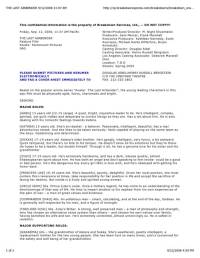Judge Denies Attorneys' Attempt to Shield Evidence
Table of Contents
Main article: Parties in Axanar Case Oppose Summary Judgment
See also: Defense, Plaintiffs Rebut Opposition to Summary Judgment
In an order filed December 9, 2016, federal Judge R. Gary Klausner dinged attempts by attorneys for both Axanar and the studios suing it for copyright infringement to file documents under seal — preventing their attempt to effectively hide that evidence from public scrutiny.
The judge, who recently warned attorneys that without adequate justification he would automatically deny such attempts, rejected the defense’s effort to submit two documents under seal.
Rejected Redactions

The documents at issue were part of the evidence both sides filed to support their own motions for summary judgment:
- Exhibit 2 to the declaration by Axanar attorney Brian Li-A-Ping Declaration (in its entirety),1) identified by the defense as excerpts from the deposition of witness Daniel O’Rourke, who testified for plaintiffs CBS and Paramount Pictures. Li-A-Ping is an attorney for Winston & Strawn, the firm representing Axanar pro bono in the lawsuit.
- Exhibit MMM to the declaration by studio attorney David Grossman of an Axanar casting document which Defendants wanted hidden from the public.2)
It remains unclear why a production its lawyers continually characterize as a non-commercial fan film has trade secrets to protect.
O'Rourke Deposition
The defense wanted to file under seal all the excerpts from the September 30 deposition of the plaintiffs’ witness, Daniel O’Rourke, Paramount’s vice-president of rights and research. The studios had designated his testimony as “confidential,” and Axanar attorney Erin Ranahan had told the judge:
Counsel for Defendants conferred with counsel for Plaintiffs on whether Exhibit 2 … could be de-designated to avoid the need to file the Exhibit under seal. … Plaintiffs requested that Defendants file Exhibit 2 under seal.3)
Plaintiffs Lacked Justification
According to Ranahan, it was up to the studios’ attorneys to justify why O’Rourke’s testimony deserved to remain confidential:
What Happens to Unredacted Documents?
The excerpt from O’Rourke’s unredacted deposition was filed with the court on December 13. It’s not clear what will happen to the other document the judge refused to bar from the public — whether the parties will get another chance to justify filing under seal, whether it will be released unredacted to the public, or if the defense can withdraw the document.
Axanar Casting Document
As part of his reply to the defense’s opposition to the studios’ request for a partial summary judgment, their attorney, Grossman, submitted Exhibit MMM, a document discussed by Prelude director Christian Gossett in his deposition titled, “Casting Announcement/Breakdown: Star Trek Axanar.”
In his declaration, Grossman’s quotation from that casting document was completely redacted.6)
Judge Klausner rejected the request to keep the document hidden, leading Grossman to file the unredacted version on December 19. The full document makes clear why the plaintiffs cited the document and likely what the defendants sought to keep from public view.
What Axanar Was Hiding
The studios’ declaration of what they considered undisputed facts referred to evidence from the plaintiffs’ depositions of Peters and Axanar director Robert Meyer Burnett and from the also-redacted Axanar marketing plan.
Grossman referred in the now-public casting notice Peters’ grander plan to commercialize Axanar-produced Star Trek projects. In his deposition Gossett testified Peters had “repeatedly described to him the concept that he was interested in creating alternative ways for fans to view Star Trek, and a document [Exhibit MMM] produced by Defendants states: [several lines redacted].”7)
‘PRELUDE’ DIRECTOR’S TESTIMONY
Plaintiffs’ attorney David Grossman asked Prelude director Christian Gossett to cast light on the relationship between Axanar‘s redacted casting announcement and Peters’ professional ambitions based on his use of Star Trek:
Gossett: [Peters] was excited about the idea of entertainment legitimacy.
Grossman: I’ve had marked as Exhibit 157 a two-page document … entitled “Casting Announcement Breakdown: Star Trek Axanar.” Do you recognize this document?
Gossett: I don’t.
Grossman: The document has a description of the film. It identifies you as the director. And it lists the leading roles. Do you recognize the characters that are listed there?
Gossett: I do.
Grossman: And were those characters that you and Mr. Peters had included in the draft script that you were working on?
Gossett: Yes.
Grossman: If you look at the second page of this document it says, “Axanar” – well, “Team Pitch.” It says, “Axanar is a groundbreaking film meant to show that web features can be the equal of their TV/cinema counterparts. The crew is led by professionals with a large contingent of nonunion amateurs who have worked together for years on similar projects.”
Did Mr. Peters ever describe to you the concept that he was interested in creating alternative ways for fans to view Star Trek content?
Gossett: Repeatedly.
[Axanar Attorney]: Objection. Form.8)
Gossett: Repeatedly.
Grossman: And what did he tell you about that?
Gossett: He would excitedly discuss the possibility of creating more Star Trek as we created Prelude.
Grossman: And by “more Star Trek,” do you mean more Star Trek films?
Gossett: Yes, as well as other projects.9)
The document was used by Grossman to provide context for the plaintiffs’ allegation that Peters’ creation of Axanar as a derivative work of Star Trek intellectual property posed a business threat to its owners:
Plaintiffs’ interrogatory responses and deposition testimony … extensively discuss the harm to Plaintiffs from the unchecked creation of unauthorized derivative works.10)
The Unredacted Casting Announcement
The announcement, circulated amongst Hollywood talent agencies, read:
Casting Announcement/Breakdown: Star Trek: Axanar
Title: Star Trek: Axanar
Producer: Alec Peters
Director: Christian Gossett
Description: Feature film. Science Fiction Drama. Set in the Star Trek Universe 20 years before the time of Kirk, Spock & McCoy. Axanar is the story of Garth of Izar, the legendary captain who won a decisive victory at the Battle of Axanar.
Format: HD Video, SAG New Media
The announcement (view PDF) goes on to describe three leadings roles (a first officer, a shape-shifting intelligence officer and a tactical officer) and three supporting roles.
Justification
Presumably, of the justifications available under the protective order in the case governing evidence, the defense wanted this information kept from the public because it constituted “confidential and proprietary business or commercial information or trade secrets.”11)
However, it remains unclear why a production its lawyers continually characterize as a non-commercial fan film has to keep secret “proprietary business or commercial information,” or what trade secrets such a fan venture would need to protect.
About Casting Announcements
Casting announcements and breakdowns are disseminated to actors’ agents describing the project. Such notices typically include the production title, union status, independent or studio project, the film’s projected length, location, production company, its website, director, producer, casting director and how much actors will be paid (usually dictated by its union status) and audition dates.
Such documents also include a synopsis of the film and a detailed description and background for each of the characters the production seeks to cast.
Judge's Warning
Klausner had warned defense attorneys in a November 30 order that simply relying on the protective order in the case to justify hiding information from the public was insufficient; under the court’s standing rule adequate explanation detailing why a given document might be redacted must be included in requests to file under seal:
Regarding defendant’s application … the parties are reminded that pursuant to Court’s Revised Standing Order 16, “if a party submits an application to file under seal pursuant to a protective order only, (i.e., no other reason is given), the Court will automatically deny the application if the party designating the material as confidential does not file a declaration.12)
Protective Order
Axanar’s attorneys tried to keep the evidence from the public based on a protective order issued by federal magistrate Judge Charles F. Eick governing discovery, the evidence-gathering process by both sides in the case.
What's Protected?
According to the order, the type of information deserving confidential status, included:
- Private and highly sensitive financial information regarding revenues, expenses and profits from the motion picture works involved in the case. The intention here was to prevent competitors from obtaining such information.
- Drafts of scripts and other creative material, including unreleased portions of the films in dispute, in order to prevent competitive harm to the parties.
- Personal financial data of third parties, including writers, producers and directors not a party in the case.
- All confidential and proprietary business or commercial information or trade secrets.13)
Keywords


